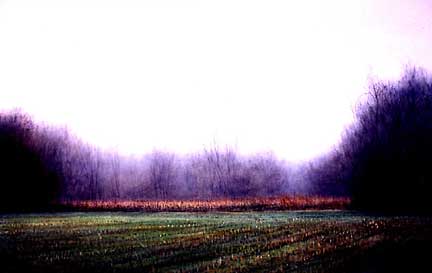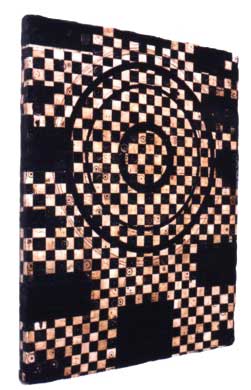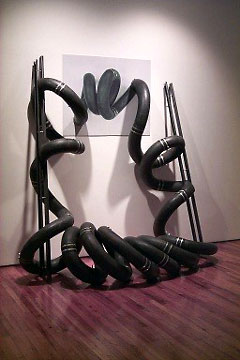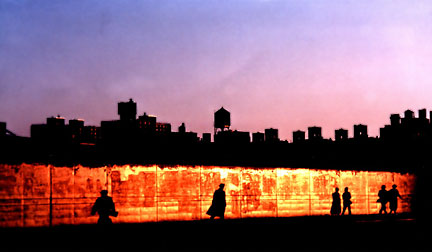 |
Bart
Elsbach
Harvest to Northern Mist -1999
oil on canvas
20 x 28 inches
51 x 71 cm
Bart Elsbach was born and raised in Manhattan, where he studied at the Art Students League and received
a Master of Fine Arts from New York University. He presently lives in Sheffield, MA. Although most of his
work depicts New England scenes, he has also painted in the Midwest and the West Coast. In 1990 he
spent seven months painting in England, France and Holland. His work is deeply influenced by the European
tradition, especially the Dutch Masters, and by the Hudson River School.
As I walk through fields and along rivers and roads, sketchbook and easel in hand, I take visual notes. Some
of these preliminary sketches lead to more finished drawings and paintings. Generally I work by building up
layers of pigment, trying to create a sense of depth and intricacy. I draw with pens because of the heavy
darks I can build with them. I use oil paint because of its richness.
I am drawn to particular references because of concrete elements and how they are arranged: an intriguing
juxtaposition of colors, the sharp contrast of areas struck by light or a subtle transition from shadow to
highlight. I am also pulled by less easily defined qualities which create a symbolic context that I may only
recognize after a painting is finished, or after a whole series of images have evolved.
When I look at the world I try to understand how it is put together: how the little pieces I am seeing are
connected to each other and to the pieces of larger realms that ripple forever outward. When I look at a
landscape I see shapes within shapes. Some shapes connect to others gently and gracefully, others seem
to be embattled. I see colors, and colors mixing with the atmosphere between them and me. I look at the
possibilities for compositions that are created. I try to see pieces of the scene in front of me as complete
images. I also try to understand which key aspect(s) of a reference are most intriguing and imagine how I
might cultivate that intrigue. I imagine how I would use pigments to evoke the patterns and marks in fields
and trees or the way light chances on a tree line, its movement so infinitely complex and varied and yet
somehow so constant and simple.
Bart Elsbach
February 2000
 |
Douglas Bond
Foiled Potatoes-Gray - 2000
acrylic on canvas
34 x 43 inches
86 x 109 cm
My recent paintings are altered translations of photographic imagery culled from various mass media publications collected over the years. Rough and finished drawings are carefully rendered from a chosen photograph. To enhance and clarify an image I often draw from live models and objects as well. If needed, photographs of the same are taken for later reference. Next, slides of the found photographs, drawings, and models are projected onto the studio wall to determine an agreeable scale (usually much larger than life). Finally, a number of canvases are constructed to begin painting variations of a single image. Before finishing the first painting of a series, two or three other variations are started and worked on intermittently. This process seems to help resolve difficult passages and to lengthen the viewing time needed to complete a painting. The content of this exhibition focuses on kitchen activities and culinary objects. When I work from a black and white photograph, a color or color system needs to be decided upon. This is usually suggested by the content or possibly contradictory choices that redirect the mood of the image. For example, the act of kneading dough would best be done in a bright, fluorescent light. However, when this ritual is painted in deep blue-purple, as if lit by the moon, questions arise. By skewing the original context it allows the viewer to search for an aesthetic value and social relevance beyond the intended communication of the source subject matter. Whatever the altercation, surrealism and sentimentality are not allowed in the house. Through the reordering of genre scene subject matter, the paintings are presented in a somewhat incongruent manner that is intended to stimulate, assault, amuse, and otherwise pose problems of contemplation. Douglas Bond January 05, 2000
 |
Hiroyuki
Hamada
Untitled - 1997-1999
burlap, enamel, plaster, tar, wax and wood
39.5 x 32 inches
100.30 x 81.30
Some of my pieces emphasize the making process. The material itself speaks loudly in some pieces. My
nature weighs heavily in others. I like to feel that all of these interlock on different levels and create a certain
presence. I like this point, where the material becomes more than the material.
Hiroyuki Hamada
January, 2000
 |
David
Jensz
Mobius - 1999
steel, rubber tire tubes, air
96.5 x 86.5 x 51 inches
2455 x 220 x 130 cm
Ideas evolve from a process of considering the potential of my materials. While the materials are chosen initially for their intrinsic qualities; weight, density, colour, texture, strength, etc, I try to present them in new ways. Objects and materials have meanings and associations that develop because of their physical nature, their use and our perceptions of them - symbolic, cultural and historical. Ideas occur as mental images that gradually become concrete as the work is constructed. I often use several materials in each work so that in total, they convey more than each of the materials could express individually. The combination can suggest a sense transformation: either a change between states, or between contrasting properties from water to clay, timber to coal, coal to fire, wax to oil, coal to gold, etc. I want the idea to transcend the work itself and go beyond the physical reality of the final piece. Formally the work relies on the visual and textural qualities of the materials in highly refined arrangements. Simplicity in the work alludes to or implies greater complexity, while a sense of balance held almost at equilibrium implies the necessity for change. The work needs to be physically convincing and I enjoy the effect of gravity on the process of resolving the work. The best ideas evolve beyond the original conception and I end up outside the limitations of my original matrix of thought. Recently I have been influenced by writers like Steven Hawking, Michio Kaku and Paul Davies, who have made the physical laws of nature and origin of the universe accessible. I find however, that some of their ideas are so far outside my daily reality, that I have become conscious of a gap between what I understand intellectually, and how I live my life day to day. One of the motivating forces in making my work is to try to bridge this gap. David Jensz November, 1999
 |
Moses
Hoskins
Untitled - 1999
wastepaper on cardboard
16 x 20 inches
40.64 x 51 cm
Working in a variety of media, I address physical process in relationship to aesthetic development. Creation of an achieved ultimate presence is the culminating objective. That is what "making art" is to me. These collages are lifted from a series comprised of wastepaper mounted on cardboard. The actual materials are not the dominant focus although no attempts are made to disguise their physical properties. Attention is given to form and shape, line and edge, solid mass and negative space with each piece emerging to attain individual uniqueness. There is occasional consideration for color but in this work the emphasis has more to do with these other various components of overall composition. It is best to simply look and ponder. Each piece is untitled. Moses Hoskins February, 2000
 |
Steven
Siegel
Manhattan At Twilight - 1988
ilfochrome print
11 x 14 inches
28 x 35.5 cm
Like millions of people, I am drawn to photographing New York's landmarks, neighborhoods and streets. I photograph these subjects knowing full well that the icons of New York are reproduced everywhere and hat their omnipresence seemingly has relegated them to banality. Thus, it is a daunting challenge to produce a new and compelling photograph of say, the Empire State Building, the Statue of Liberty, the Brooklyn Bridge or a well-known New York neighborhood. But the challenge is hard to resist because New York landmarks and architecture continue to exert their raw visceral power on all who choose to submit to them. The best way to overcome a cliché, whether photographic or otherwise, is to restore the subject to its original meaning and power. This is of course, no easy task. In my work I have attempted to surmount this challenge in a variety of ways. For example, one of my special interests is to photograph New York's landmarks and neighborhoods during extraordinary outdoor lighting and weather conditions. Over the years I have managed to photograph the Manhattan skyline shrouded in fog, topped by storm clouds or engulfed in "fire" produced by the late afternoon sun. In some instances, the photos are the result of sheer luck: being at the right place at the tight time with a camera. In other instances, it was a race against time, the sun and the atmosphere that permitted me to arrive at an interesting location before a fog blanket evaporated or dramatic black-topped clouds turned to gray rain. In still other instances, the photo required a mixture of luck and calculation. For example, at certain times of the year at a few locations in the New Jersey Meadowlands, the entire Manhattan skyline appears to be consumed in the "fire" produced by the setting sun. This extraordinary sight persists for about three minutes and may not be present at all because of clouds or smog. Getting to the right location at the correct time under optimal atmospheric conditions is not unlike tracking the narrow path of a solar eclipse. It's a heroic quest to place myself at the convergence of some rare astronomical and meteorological event. The act of photography is a moment of exhilaration, and the photograph is a record of it. I also am drawn to photographing New York's familiar landmarks from vantage points that incorporate provocative or disturbing foreground subject matter. Typical examples of my work that employ this approach are the Manhattan skyline as seen from the South Bronx, Long Island City and Port Newark. Or the Statue of Liberty framed by highways, factories, scrap yards and piers. These photos are the products of determined treks through lesser-known neighborhoods and remote industrial and natural areas scattered throughout the New York region. Some viewers of these photographs, when confronted with a juxtaposition of familiar landmarks and unfamiliar foreground subject matter, assume that the composition was the result of digital manipulation. When I assure the viewer that this is not the case, the viewer usually responds by asking. Where did you take this photo? I am always glad to answer this question because it is my hope that these photos may inspire some people to conduct their own explorations of the New York region: to walk, to ride, to drive, to explore with no particular purpose other than to learn how and where people live and work in this most complex of urban areas. This aimless pursuit has been my hobby for over 25 years. Finally, I am drawn to the New York streets and the astounding variety of people who populate them. The New York street it has been often said, is a place of extremes. It is a metaphor for human diversity, tolerance and the First Amendment just as surely, it is a metaphor for alienation and despair. For the photographer, the choice of metaphor is often a matter of waiting a few extra seconds. Or the metaphors may be presented side-by-side, a composition for which the New York street is particularly well suited. I generally avoid conventional posed portraits. Far more interesting to me is the hurly-burly tableau of the street and the challenge of showing people acting and reacting to the world around them. Often my approach is to select a building, wall or sign as a static background and wait for interesting dynamic elements to appear. Usually the process is one of exclusion, that is, the removal of extraneous elements through careful framing or waiting for some elements (such as cars) to leave the frame, In this context, the photographers art derives almost entirely from the selection of the moment in which to trip the shutter. Yet, on the New York street in particular, this margin of discretion is enormous. Whether this process reveals an essential truth or is inherently deceptive and manipulative. I leave for others to decide. Steven Siegel February, 2000
This web site was designed and created by REDRUM DESIGNS ©1999 OK HARRIS All Rights Reserved